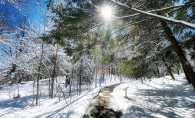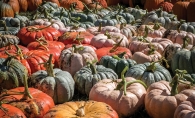Deb Revier’s back yard always has been centered around the idea of contrast. When she first moved into her home nearly 20 years ago, however, contrast wasn’t necessarily a good thing. There, amidst her serene, wooded backyard, sat a squat pile of discarded excavation dirt, held together by a tired retaining wall, with a few lonely marigolds scattered on top.
The quiet beauty of the area’s towering trees and calm waterfront had been overshadowed by this man-made eye-sore, and it became Revier’s goal to restore Minnesota’s native beauty to her property. After much blood, sweat and tears, Revier’s backyard now supports a thriving garden of flowers and foliage, about 80 percent of which are truly native to Minnesota. Her gardens have been featured in Lynn Steiner’s Landscaping with Native Plants in Minnesota, and have been showcased on many local horticultural tours, including the 2010 Hennepin County Master Gardeners Learning Garden Tour.
Revier encourages other Minnesotans to share in her appreciation for our state’s natural flora, and took some time to discuss how she transformed a haphazard pile of dirt into a garden retreat which perfectly illustrates the diversity of Minnesota’s native plants.
Start big! Revier recommends first outlining your garden space, and then placing keystone plants like large bushes and trees, which will give structure to your property, define your garden and create an element of depth.
Revier hired a landscape designer to help her cut down and re-imagine the overwhelming landmass that stood between her house and the pond that sits at the bottom of her property. She ultimately opted to keep some of the mound intact, as large shade trees had already rooted themselves. After establishing the shape and contours of her garden, Revier and her designer added “holey boulders”—large, dimpled, boulders native to Wisconsin, which added an element of interest and further enhanced the rugged, woodland look of her developing garden. Small trees such as the white-flowered Pagoda Dogwood and larger bushes like the bright-fruited Chokeberry complete the structural component and create a substantial base for the rest of the garden.
Fill in with medium-size shrubs. Once the framework of the garden is established, add visual appeal with larger, space-occupying plants and shrubs of various heights, color palates and textures.
According to Revier, “the problem with perennials and a lot of the native flowers is that you get a flush of color in the spring, but then your garden is ‘blah’ for the rest of the year.” An easy remedy to this problem comes in varying the size and textures of larger plants, instead of relying entirely on bloom color for interest. Revier recommends the dark, smoky foliage of the Ninebark and the white-edged, heart shaped leaves of the Brunnera vine. The feathery fronds of the delicate ferns contrast nicely against the short, broad-leafed Wild Ginger, and the vibrant berries of the Baneberry and Highbush Cranberry offer a punch of color that can outlast any flower blossom.
Back-fill with smaller flowers and high-impact colors. No matter how stately your backdrop or how versatile your foliage, every gardener still anticipates the first vivid blooms of the season. Adding a few pops of color to a well-designed framework will give you a balanced garden that changes with the season.
For a state that can be buried under snow for half the year, Minnesota offers a surprising diversity of native flowers. Revier favors flowers like the Siberian Iris, with its elegant, dusty-green foliage and single violet bloom. Vibrant magenta and cherry-red Monardas are reminiscent of summer fireworks, while feathery Goat’s Beard invokes thoughts of winter snow. Strong, stoic Coneflowers tower over delicate, dusky-pink tufts of Prairie Smoke. And a single, sunny Coreopsis bloom sits atop a slender green stem, while clusters of dense Virginia Bluebells huddle close to the ground.
The potential combinations of color, height and texture offer endless opportunities to compare and contrast Minnesota’s vast diversity of flora—a very different type of contrast than what Revier started out with 10 years ago.









